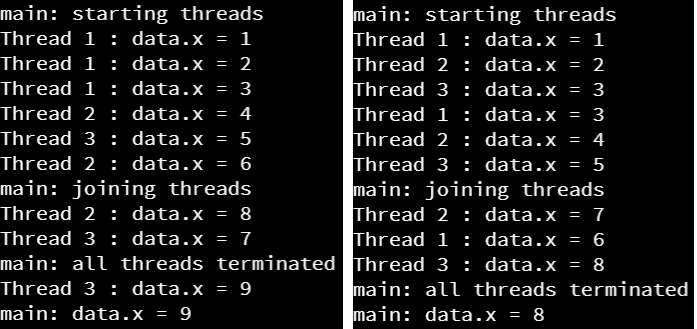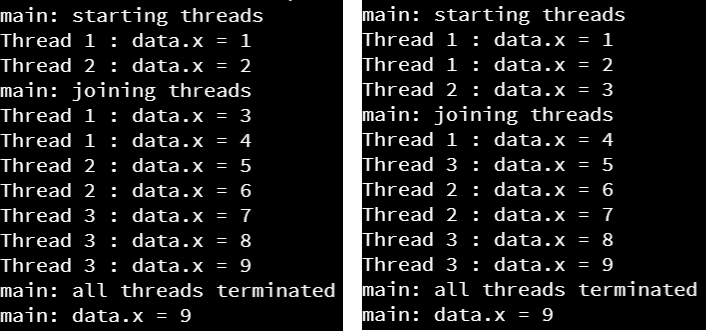Python Synchronization
Next, let’s look at a quick example of a race condition in Python, just so we can see how it could occur in our code.
Poorly Designed Multithreading
First, let’s consider this example:
import threading
import time
import sys
class MyData:
def __init__(self):
self.x = 0
class MyThread:
data = MyData()
def __init__(self, name):
"""Constructor.
Args:
name: the name of the thread
"""
self.__name = name
def run(self):
"""Thread method."""
for i in range(0, 3):
y = MyThread.data.x
# tell the OS it is ok to switch to another thread here
time.sleep(0)
MyThread.data.x = y + 1
print("{} : data.x = {}".format(self.__name, MyThread.data.x))
@staticmethod
def main(args):
# create threads
t1_object = MyThread("Thread 1")
thread1 = threading.Thread(target=t1_object.run)
t2_object = MyThread("Thread 2")
thread2 = threading.Thread(target=t2_object.run)
t3_object = MyThread("Thread 3")
thread3 = threading.Thread(target=t3_object.run)
# start threads
print("main: starting threads")
thread1.start()
thread2.start()
thread3.start()
# wait until all threads have terminated
print("main: joining threads")
thread1.join()
thread2.join()
thread3.join()
print("main: all threads terminated")
print("main: data.x = {}".format(MyThread.data.x))
# main guard
if __name__ == "__main__":
MyThread.main(sys.argv)Explanation
In this example, we are creating a static instance of the MyData class, attached directly to the MyThread class and not a particular object, which can act as a shared memory object for this example. Then, in each of the threads, we are performing this three-step process:
y = MyThread.data.x
# tell the OS it is ok to switch to another thread here
time.sleep(0)
MyThread.data.x = y + 1Just as we saw in the earlier example, we are reading the current value stored in data.x into a variable y. Then, we are using the time.sleep(0) method to tell the operating system to put this thread to sleep, but then immediately add it back to the list of threads to be scheduled on the processor. Finally, we update the value stored in data.x to be one larger than the value we saved earlier.
In effect, this is essentially the Python code needed to reproduce the example we saw earlier in this class.
Execution
So, what happens when we run this code? As it turns out, sometimes we’ll see it get a different result than the one we expect:
Uh oh! This is exactly what a race condition looks like in practice. In the screenshot on the right, we see that two threads set the same value into data.x, which means that they were running at the same time.
Python Lock
To fix this, Python includes a lock that we can use as part of a with statement, which is simply a wrapper around a block of code that we’d like to be atomic. An atomic block is one that shouldn’t be broken apart and interrupted by other threads accessing the same object. In effect, using a with statement along with a lock will handle acquiring and releasing the lock for us.
So, in this example, we can update the MyThread class to have a lock:
class MyThread:
data = MyData()
lock = threading.Lock()When, we can update the run() method to use a with statement:
def run(self):
for i in range(0, 3):
with MyThread.lock:
y = MyThread.data.x
# tell the OS it is ok to switch to another thread here
time.sleep(0)
MyThread.data.x = y + 1
print("{} : data.x = {}".format(self.__name, MyThread.data.x))
time.sleep(0)Here, the with statement acquires the lock that is associated with the data object in the MyThread class. Only one thread can hold that lock at a time, and by associating it with an object, we can easily keep track of which thread is able to access that object.
Now, when we execute that program, we’ll always get the correct answer!
Not Always Random?
In fact, to get the threads interleaved as shown in this screenshot, we had to add additional time.sleep(0) statements to the code! Otherwise, the program always seemed to schedule the threads in the same order on Codio. We cannot guarantee it will always happen like that, but it is an interesting quirk you can observe in multithreaded code. In practice, sometimes race conditions may only happen once in a million operations, making them extremely difficult to debug when they happen.

